热带气旋通过斐济时TRMM多卫星降水分析的评价
IF 3.6
4区 地球科学
Q1 Earth and Planetary Sciences
引用次数: 0
摘要
斐济容易受到热带气旋通过期间强降雨的破坏性影响,因此,在这种情况下准确测量降雨量对于有效减轻灾害和分析风险来说是迫切需要的。然而,斐济雨量计分布稀少,因此在精确测量雨量方面存在不足。这一差距可以通过基于卫星的降雨估计来填补,但在使用之前,需要根据参考数据集对其准确性和局限性进行验证。因此,这项研究验证了基于TRMM的多卫星降水分析(TMPA)对斐济岛的估计。研究表明,TMPA在估计TCs通过斐济岛期间的降雨量方面具有中等技能。这一技能也是高度可变的,因为它随着降雨强度的增加、与气旋中心距离的增加和地形高度的增加而减少。TMPA的能力也因情况而异,但我们报告了在降雨量较大的tc(在我们的案例中定义为平均日降雨量大于25毫米的tc)通过期间,TMPA对降雨量的普遍低估。本文章由计算机程序翻译,如有差异,请以英文原文为准。
Evaluation of TRMM Multi-satellite Precipitation Analysis during the passage of Tropical Cyclones over Fiji
Fiji is prone to the devastating effects of heavy rainfall during the passage of tropical cyclones (TCs) and as such accurate measurement of rainfall during such events is urgent for effective disaster mitigation and risk analysis. Fiji, however, has a sparse distribution of rain gauges, thus there is a deficiency in the accurate measurement of rainfall. This gap could be filled by satellite-based rainfall estimates but before they are used, they need to be validated against a reference dataset for their accuracy and limitations. This study thus validates the TRMM based Multi-satellite Precipitation Analysis (TMPA) estimates over the island of Fiji. The study shows that TMPA has moderate skill in estimating rainfall during the passage of TCs over the island of Fiji. This skill is also highly variable as it decreases with an increase in rainfall intensity, increase in distance from the cyclone centre and increasing terrain elevation. The ability of TMPA also varies case by case but we report a general underestimation of rainfall by TMPA during the passage of TCs with a larger rainfall rate (defined in our case as those TCs with average daily rainfall greater than 25 mm day-1).
求助全文
通过发布文献求助,成功后即可免费获取论文全文。
去求助
来源期刊

Journal of Southern Hemisphere Earth Systems Science
Earth and Planetary Sciences-Oceanography
CiteScore
8.10
自引率
8.30%
发文量
0
审稿时长
>12 weeks
期刊介绍:
The Journal of Southern Hemisphere Earth Systems Science (JSHESS) publishes broad areas of research with a distinct emphasis on the Southern Hemisphere. The scope of the Journal encompasses the study of the mean state, variability and change of the atmosphere, oceans, and land surface, including the cryosphere, from hemispheric to regional scales.
general circulation of the atmosphere and oceans,
climate change and variability ,
climate impacts,
climate modelling ,
past change in the climate system including palaeoclimate variability,
atmospheric dynamics,
synoptic meteorology,
mesoscale meteorology and severe weather,
tropical meteorology,
observation systems,
remote sensing of atmospheric, oceanic and land surface processes,
weather, climate and ocean prediction,
atmospheric and oceanic composition and chemistry,
physical oceanography,
air‐sea interactions,
coastal zone processes,
hydrology,
cryosphere‐atmosphere interactions,
land surface‐atmosphere interactions,
space weather, including impacts and mitigation on technology,
ionospheric, magnetospheric, auroral and space physics,
data assimilation applied to the above subject areas .
Authors are encouraged to contact the Editor for specific advice on whether the subject matter of a proposed submission is appropriate for the Journal of Southern Hemisphere Earth Systems Science.
 求助内容:
求助内容: 应助结果提醒方式:
应助结果提醒方式:


